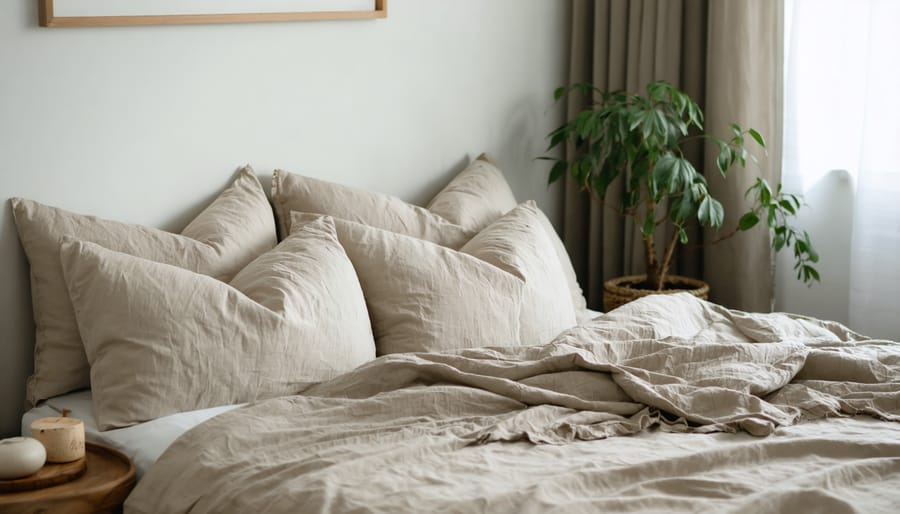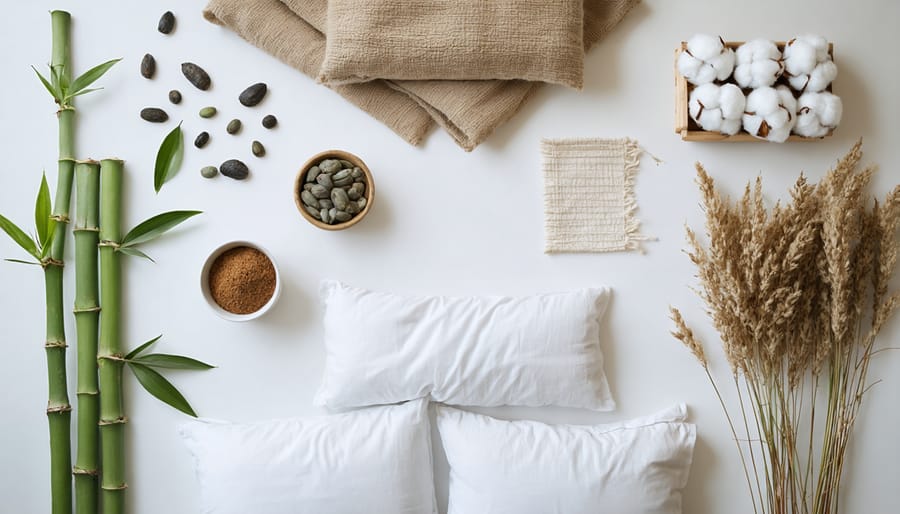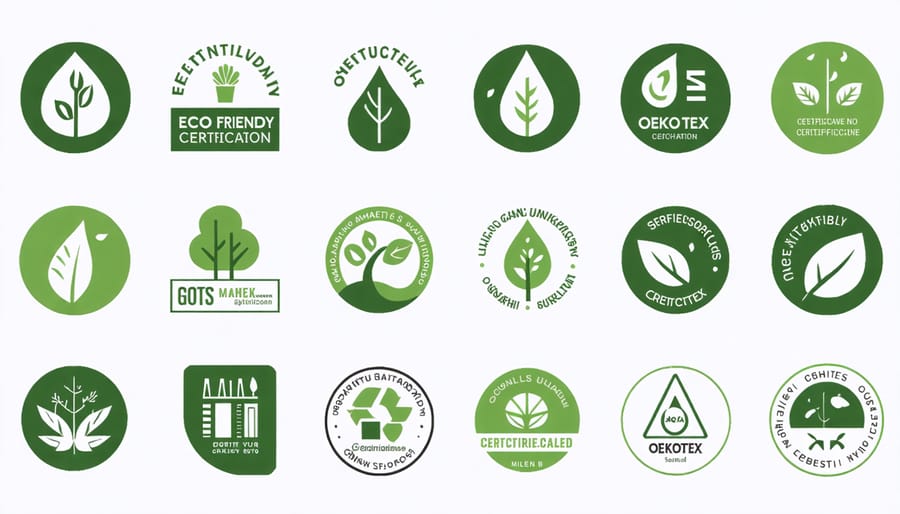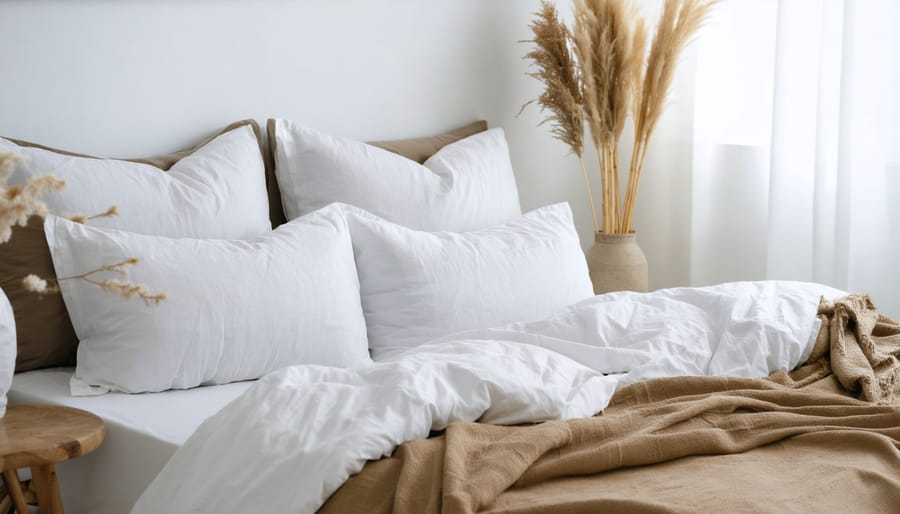
Sleep Better Tonight with Earth-Friendly Bedding (That Actually Feels Amazing)
Transform your bedroom into a sustainable sanctuary by choosing organic cotton, bamboo, or hemp bedding certified by GOTS (Global Organic Textile Standard) or OEKO-TEX. These materials minimize environmental impact while delivering exceptional comfort and durability. Select naturally dyed bedding free from harsh chemicals and synthetic materials to create healthier eco-friendly home choices that promote better sleep. Invest in high-quality, sustainable bedding that’s designed to last, reducing waste and replacement frequency while supporting ethical manufacturing practices. Look for bedding companies that prioritize sustainable packaging, carbon-neutral shipping, and transparent supply chains to ensure your purchase aligns with environmental values.
Focus on bedding that combines environmental responsibility with practical comfort – materials that breathe well, regulate temperature naturally, and become softer with each wash. These conscious choices not only support planetary health but also create a more restful, chemical-free sleeping environment that benefits your wellbeing for years to come.
What Makes Bedding Truly Eco-Friendly?
Sustainable Materials to Look For
When choosing eco-friendly bedding, several sustainable materials stand out for their environmental benefits and comfort. Organic cotton leads the pack as one of the most popular durable fabric options, grown without harmful pesticides and processed using less water than conventional cotton. Bamboo fabric has gained popularity for its naturally antimicrobial properties and incredibly soft texture, while also being one of the fastest-growing renewable resources.
Hemp deserves special attention as a sustainable superstar – it grows quickly without pesticides, requires minimal water, and produces incredibly strong fibers that become softer with each wash. Tencel (Lyocell) is another excellent choice, made from sustainably harvested wood pulp in a closed-loop process that reuses water and solvents.
For those seeking alternative materials, linen made from flax plants offers exceptional breathability and gets better with age. Look for certifications like GOTS (Global Organic Textile Standard) or OEKO-TEX to ensure your bedding meets strict environmental and social standards. These materials not only support a healthier planet but also provide superior comfort and longevity.

Certifications That Matter
When shopping for eco-friendly bedding, certain certifications serve as your compass for making truly sustainable choices. The Global Organic Textile Standard (GOTS) is the gold standard in organic textiles, ensuring that products contain at least 95% organic fibers and meet strict environmental and social criteria throughout production.
OEKO-TEX Standard 100 certification guarantees that every component of your bedding has been tested for harmful substances, making it safe for human use. While not specifically focused on organic materials, it’s a crucial certification for health-conscious consumers.
The MADE SAFE certification goes beyond fabric testing, verifying that products are made without known harmful chemicals or ingredients that could impact human health or the environment. For those seeking fair trade practices, Fair Trade Certified bedding ensures ethical working conditions and fair wages for workers.
Look for these certifications on product labels or company websites – they’re your assurance that the bedding meets rigorous environmental and social standards. Remember that some products may carry multiple certifications, offering extra peace of mind for your sustainable choice.


Top Eco-Friendly Bedding Options
Sheets and Pillowcases
When it comes to eco-friendly sheets and pillowcases, organic cotton leads the pack as a sustainable choice. These bedding essentials are grown without harmful pesticides and processed using environmentally responsible methods. Look for GOTS (Global Organic Textile Standard) certification to ensure you’re getting genuinely sustainable products.
Bamboo sheets offer another excellent green option, known for their silky feel and natural temperature-regulating properties. Made from renewable bamboo plants, these sheets require minimal water and no pesticides to grow. They’re particularly good for hot sleepers, as bamboo naturally wicks away moisture.
Hemp sheets are gaining popularity in the sustainable bedding market. This durable material grows quickly without pesticides and becomes softer with each wash. While initially more expensive, hemp sheets often outlast conventional options, making them cost-effective in the long run.
For those seeking luxury with a conscience, Tencel lyocell sheets provide a sustainable alternative to conventional fabrics. Created from wood pulp in a closed-loop process, Tencel production uses less water and energy than traditional cotton processing.
When shopping for eco-friendly sheets, pay attention to the thread count, but don’t let it be your only guide. A moderate thread count (300-500) from high-quality sustainable materials often performs better than higher thread counts from conventional sources. Look for natural dyes and avoid sheets with wrinkle-resistant treatments, as these often contain harmful chemicals.
Comforters and Duvets
When it comes to eco-friendly comforters and duvets, the filling material makes all the difference. Natural options like organic cotton, wool, and kapok fiber offer excellent insulation while being biodegradable and renewable. Wool stands out for its temperature-regulating properties, keeping you warm in winter and cool in summer, while also being naturally resistant to dust mites and mold.
For those seeking vegan alternatives, recycled polyester filling made from post-consumer plastic bottles provides a sustainable solution without compromising on comfort. These materials are often just as fluffy and warm as traditional down, but with a much smaller environmental footprint.
The outer cover material is equally important. Look for organic cotton, hemp, or bamboo lyocell covers, which are grown without harmful pesticides and processed using eco-friendly methods. These materials are not only better for the environment but also tend to be more durable and softer with each wash.
Consider duvet covers with natural dyes or those certified by GOTS (Global Organic Textile Standard) to ensure the highest environmental standards. For maximum sustainability, choose products with button or tie closures instead of zippers, as these are easier to repair and typically last longer.
Remember to check care labels – many eco-friendly comforters can be machine washed in cold water, reducing energy consumption while extending the life of your bedding.
Pillows and Mattress Toppers
When it comes to sustainable comfort, choosing the right pillows and mattress toppers can make a significant difference in both your sleep quality and environmental impact. Natural latex stands out as a premier eco-friendly filling material, offering excellent support while being biodegradable and sustainably harvested. Organic wool is another outstanding option, providing natural temperature regulation and moisture-wicking properties without synthetic additives.
For those seeking plant-based alternatives, pillows and toppers filled with organic buckwheat hulls or kapok fiber offer excellent support while being completely biodegradable. Kapok, harvested from the ceiba tree, feels remarkably similar to down but is entirely plant-based and cruelty-free.
Look for products with GOTS (Global Organic Textile Standard) or GOLS (Global Organic Latex Standard) certifications to ensure authentic organic materials. The outer covers should ideally be made from organic cotton or hemp, which are grown without harmful pesticides and processed using eco-friendly methods.
Consider the lifespan of your bedding investments – quality eco-friendly pillows and toppers typically last longer than conventional alternatives, reducing waste and replacement frequency. Many manufacturers now offer take-back programs for proper recycling or composting at the end of the product’s life.
For optimal maintenance, most natural filling materials can be spot-cleaned and air-dried, extending their life while minimizing environmental impact from washing.
Care and Maintenance
Washing and Drying Tips
Caring for your eco-friendly bedding properly not only extends its lifespan but also maintains its sustainable qualities. Start by washing your bedding in cold water whenever possible, as this reduces energy consumption and prevents fiber damage. Use plant-based, biodegradable detergents that are free from harsh chemicals and phosphates. These gentle cleaners are better for both your bedding and the environment.
Avoid overloading your washing machine, as this can prevent proper cleaning and cause unnecessary wear. For optimal results, wash similar items together and turn duvet covers inside out before washing. If you have delicate organic cotton or hemp bedding, use the gentle cycle to preserve the fibers.
When it comes to drying, opt for air-drying whenever weather permits. Line-drying in sunshine not only saves energy but also naturally disinfects and freshens your bedding. If you must use a dryer, choose a low-heat setting and remove items promptly to prevent wrinkles. Consider using wool dryer balls instead of fabric softener sheets – they reduce drying time and are reusable.
For stubborn stains, try natural solutions like white vinegar, baking soda, or lemon juice before reaching for chemical spot cleaners. Regular maintenance, such as weekly washing and proper storage in a cool, dry place, will help your eco-friendly bedding maintain its quality while minimizing environmental impact.
Extending Lifespan
Proper care and maintenance of your eco-friendly bedding not only protects your investment but also reduces environmental impact by extending its lifespan. Start by following care labels precisely, as natural fibers often require specific washing temperatures and methods. Use cold or lukewarm water when possible, and opt for gentle, plant-based detergents to preserve fabric integrity while minimizing chemical exposure.
Rotate your bedding regularly to distribute wear evenly, and consider using multiple sets to reduce laundering frequency. When storing spare bedding, ensure it’s completely dry and keep it in a cool, dry place in breathable cotton bags rather than plastic containers. This prevents moisture buildup and potential mildew growth.
For optimal care, air your bedding outside on sunny days when possible – natural sunlight acts as a natural disinfectant and deodorizer. Address stains immediately using natural spot-cleaning solutions like vinegar or baking soda paste rather than harsh chemical cleaners.
To prevent unnecessary wear, remove jewelry before bed and keep pets’ nails trimmed if they share your sleeping space. Consider using a high-quality mattress protector to shield your bedding from spills and body oils. During warmer months, a light cotton cover can protect your main bedding while keeping you comfortable, effectively doubling its lifespan.
Remember that quality eco-friendly bedding is an investment in both comfort and sustainability – treating it with care ensures you’ll enjoy its benefits for years to come.
Making the Switch: Budget-Friendly Tips
Making the switch to eco-friendly bedding doesn’t have to strain your wallet. Just like furnishing on a budget, transitioning to sustainable bedding can be done gradually and economically. Here’s how to make it work:
Start with one piece at a time. Instead of replacing everything at once, begin with your sheets or pillowcases. This approach spreads the cost over time while allowing you to experience the benefits of eco-friendly materials gradually.
Watch for seasonal sales, especially during Earth Month (April) when many sustainable brands offer significant discounts. Sign up for newsletters from eco-friendly bedding companies to stay informed about upcoming sales and special offers.
Consider organic cotton blend options rather than 100% organic materials as your starting point. While not purely organic, these blends offer a more affordable entry point into sustainable bedding while still being better for the environment than conventional options.
Look for certified second-hand items from luxury eco-friendly brands. Many online marketplaces now specialize in pre-owned sustainable home goods, offering high-quality pieces at fraction of their original cost.
Care for your existing bedding properly while transitioning. This extends its life and gives you more time to save for eco-friendly replacements. Use natural cleaning methods, repair small tears promptly, and rotate your bedding regularly to prevent wear.
Shop at the right time. Many retailers clear out their inventory in January and August, making these excellent months to find deals on sustainable bedding. Additionally, check outlet stores and online marketplaces that specialize in overstock items from eco-friendly brands.
Remember that investing in quality pieces, even if fewer at first, often saves money in the long run as they typically last longer than conventional alternatives. Focus on versatile, neutral colors that won’t go out of style, allowing you to build your sustainable bedding collection thoughtfully and economically over time.
Making the switch to eco-friendly bedding is more than just a trend – it’s a meaningful step toward creating a healthier home and planet. Throughout this guide, we’ve explored how sustainable materials like organic cotton, bamboo, and hemp offer superior comfort while minimizing environmental impact. These materials not only provide excellent durability and breathability but also ensure you’re not exposed to harmful chemicals during your rest.
Remember that choosing eco-friendly bedding doesn’t mean compromising on style or comfort. Today’s sustainable options come in a wide range of colors, patterns, and textures to suit any bedroom aesthetic. By investing in high-quality, environmentally responsible bedding, you’re not only creating a cozy sanctuary for yourself but also contributing to reduced water pollution, lower carbon emissions, and better working conditions for farmers and textile workers.
Start small by replacing one bedding item at a time, and pay attention to certification labels that verify environmental claims. Proper care of your eco-friendly bedding, including following manufacturer guidelines for washing and drying, will extend its life and reduce its overall environmental footprint.
By making conscious choices about our bedding, we can all play a part in creating a more sustainable future while enjoying better sleep in the process. Your bedroom can be both a personal haven and a testament to environmental responsibility.
